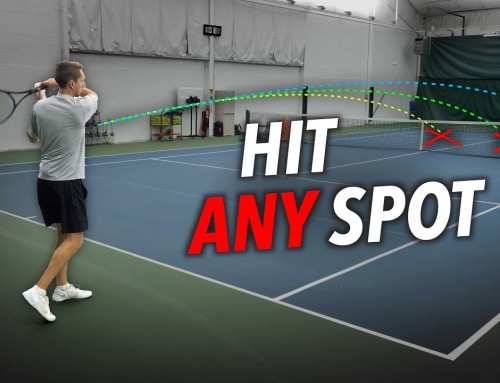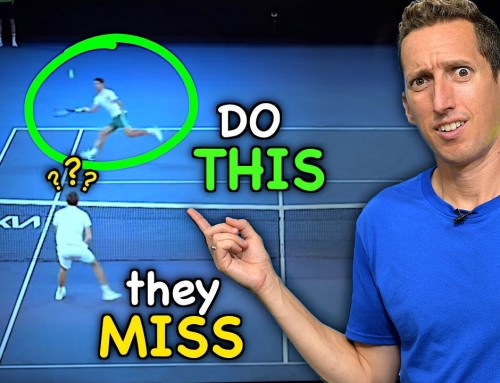Tennis is literally destroying the bodies of hundreds of thousands of players all around the world.
But it doesn’t have to be that way.
If you’re worried about experiencing tennis pain, or you’re already dealing with it and want to get rid of it for good, then what I’m about to share with you is really important. Especially if you want tennis to be a part of your life for years or decades to come.
The root cause of almost every tennis injury isn’t bad luck or aging or weak muscles.
It’s something called the kinetic chain, and most players have never heard of it.
Think of a literal chain with a bunch of different links. Your body is meant to move in a certain order, moving through those different links so that none of them are skipped and they all go in a certain sequence. That sequence is from the ground up.
You engage your strength against the ground, pushing against that force of the earth. Then you start a wave of energy coming up from your legs to your torso and hips, to the rest of your midsection, then to your shoulders and into your arm, and then out through your hand and wrist, and eventually to the racket.
This is how the pros make tennis look so easy and effortless. This is how they look so smooth while simultaneously producing tremendous power.
They utilize every link in the kinetic chain, and they utilize it in the correct order. Nothing is skipped and nothing is out of place. They get to effortlessly put all of the energy they have at their disposal smoothly into the ball.
Unfortunately, most normal tennis players don’t move their bodies this way.
As a result, they have to work much harder, and it leads to lots of pain and injury.
Let me share with you three real life examples so you can learn from them and avoid these mistakes yourself.
The first example is actually me. When you look at a world class one handed backhand, you’ll see players coil their body, meaning their shoulders and chest turn past their hips. This generates a stretch and stores a lot of energy in the body which you can then unwind and uncoil into the point of contact.
Growing up, I developed a habit of not coiling. I just turned to the side. When there’s no coil and uncoil before contact, that means a smaller link in the chain has to make up for the lack of energy and take over. When that happens, it puts a lot of strain and stress on smaller parts of the body.
About a year and a half ago, when I was trying to compete and hit aggressive one handed backhands without coiling, I tore my rotator cuff.
I had to change that habit to engage bigger, stronger parts of the body in the kinetic chain at the right time to deliver more energy, so I don’t overuse smaller parts of my body.
The second big problem players have is they might engage every part of the kinetic chain, but it’s at the wrong time and in the wrong order.
A student of mine set up strongly for her forehand. She turned her hips and shoulders 90 degrees in preparation, which is what the vast majority of high level players do. But what she was missing is that high performance players turn that 90 degrees forwards typically before the ball gets to the strings.
When we watched her forehand in slow motion, she wasn’t turning her hips or shoulders forwards until after the ball was already hit. The ball was really only being hit by her arm and shoulder.
The kinetic chain, the most important parts of it, the big strong parts, weren’t engaged until after the ball was gone.
As a result, she had really significant elbow and forearm pain because of all those small muscles having to hit the ball again and again.
Important: her hips and shoulders were turning, but it wasn’t until after the ball was already gone.
The third problem that leads to pain and injury is being overactive with a certain link in the kinetic chain. You might move all the rest of the links correctly, but if one link is overemphasized, that can lead to a lot of pain.
I recently had a student who turned his body, coiled, and rotated well in preparation for his serve. He turned forwards and uncoiled really well up to the point of contact. So far, everything was good. He was loading and unloading all the big strong parts of his kinetic chain.
But then right around contact, he was forcibly turning and twisting his hand and wrist.
When you watch world class players, they also turn their hand and wrist, but it’s done smoothly and passively. It’s not done as a conscious, deliberate, forced move. This student was making it happen as fast as possible, taking a link of the chain that was supposed to be allowed to happen and forcing it.
When you make a small part of the body twist and turn and explosively move again and again and again, it’s going to get hurt.
He was actually hiding a wrist brace under his sweatband. I didn’t know he was experiencing wrist pain until after I pointed out this really aggressive movement.
So how do we avoid these pain points creeping into our game, or eliminate them if they’re already there?
Step one: Find out for sure what’s happening with your strokes. The only way to do that is to record yourself in slow motion. It’s not good enough to watch yourself at full speed because all this stuff is happening so fast that it’s impossible to pinpoint where your timing might be a little bit off, or one link in the chain is happening too soon or too late. Record yourself in slow motion and compare it to world class examples.
Step two: Start to activate the big links in the chain that you see are stuck. Most frequently this is going to be on your forehand, backhand, or serve where you see either your hips or shoulders are inactive and not moving at all, or they might be moving but at the wrong time. Remember, a lot of times tennis players are missing performance and injuring their bodies not because of whether or not they’re turning, but when they’re turning.
Step three: Relax the small parts of your body that were previously being overworked. If you find big links in the chain that were being too passive, then smaller links were having to take over and overwork to compensate. It’s tempting to believe that once you figure it out and your hips start turning at the right time, your arm will automatically relax and be passive and smooth. But in my experience, it doesn’t just automatically work that way. You’re probably going to have to really focus and concentrate and retrain your arm to be more smooth and passive once the big links in your chain are doing their job.
Step four: Take off the braces, because now you don’t need them anymore.
Once we reengage the big parts of the body and relax the small parts of the body, not only are we hitting a better quality shot with less effort because we’re moving much more athletically and efficiently, but it removes the stress and strain on the body. The aches and pains are naturally going to disappear.
If you’re currently fighting this battle, please know I have your back. I know exactly how hard it is because I’m standing side by side with students helping them through it every day.
Keep up the great work. Your body will thank you for it.
Your Coach,
Ian







